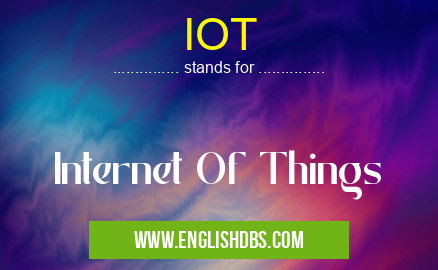What does IOT mean in TECHNOLOGY
Internet of Things (IoT) refers to the interconnected network of physical devices, vehicles, buildings, and other items embedded with electronics, software, sensors, and network connectivity, enabling these objects to collect and exchange data. IoT devices can communicate with each other, central servers, and users remotely over the internet, allowing for the monitoring and control of various aspects of our lives.

IOT meaning in Technology in Computing
IOT mostly used in an acronym Technology in Category Computing that means Internet Of Things
Shorthand: IOT,
Full Form: Internet Of Things
For more information of "Internet Of Things", see the section below.
» Computing » Technology
What does IoT Stand for
The full form of IoT is Internet of Things. It represents the concept where everyday objects are connected to the internet, enabling them to communicate and share data.
Meaning of IoT
IoT empowers smart devices to connect and interact with each other and with users. This connectivity allows for remote monitoring, control, and automation of various processes and systems. IoT devices can collect data, such as temperature, motion, and location, and transmit it to a central hub or the cloud. This data can be analyzed to gain insights, improve efficiency, and create new possibilities.
Key Features of IoT
- Connectivity: IoT devices are connected to the internet, typically through Wi-Fi, Bluetooth, or cellular networks.
- Data Collection: IoT devices can collect data from sensors and other sources, such as temperature, humidity, and motion.
- Data Analysis: Collected data from IoT devices can be analyzed to identify patterns, trends, and anomalies.
- Remote Control: IoT devices can be controlled remotely over the internet, allowing for automation and management of devices from anywhere.
Benefits of IoT
- Improved Efficiency: IoT can optimize processes and systems by automating tasks, reducing manual labor, and improving communication.
- Enhanced Decision Making: IoT provides real-time data and insights, enabling informed decision-making based on accurate information.
- New Products and Services: IoT creates opportunities for innovative products and services that leverage connectivity and data to meet evolving consumer needs.
- Convenience and Comfort: IoT devices can provide convenience by automating tasks, controlling devices remotely, and enhancing comfort levels.
Applications of IoT
IoT has found applications in various sectors, including:
- Smart Homes: Controlling smart lights, appliances, and security systems.
- Smart Cities: Monitoring traffic, air quality, and optimizing energy consumption.
- Healthcare: Remote patient monitoring, personalized medicine, and medical research.
- Industry 4.0: Automation, predictive maintenance, and supply chain optimization.
- Agriculture: Monitoring crop health, soil conditions, and livestock management.
Essential Questions and Answers on Internet Of Things in "COMPUTING»TECHNOLOGY"
What is the Internet of Things (IoT)?
The Internet of Things (IoT) refers to the network of physical devices connected to the internet, allowing them to collect and exchange data with other devices and systems. These devices can range from everyday household appliances to industrial equipment, enabling remote monitoring, control, and automation.
How does IoT work?
IoT devices are equipped with sensors, actuators, and software that allow them to collect data, process it, and communicate with other devices or cloud platforms. They typically use wireless protocols like Wi-Fi, Bluetooth, or cellular networks to connect to the internet.
What are the benefits of IoT?
IoT offers numerous benefits, including:
- Enhanced efficiency and productivity
- Improved decision-making through data analysis
- Remote monitoring and control
- Reduced costs and waste
- Increased safety and security
What are the applications of IoT?
IoT has wide-ranging applications across various industries and domains, such as:
- Smart homes: Controlling appliances, lighting, and security
- Smart cities: Optimizing traffic, managing waste, and improving public safety
- Healthcare: Monitoring patients, tracking vital signs, and administering remote care
- Manufacturing: Automating processes, optimizing supply chains, and predictive maintenance
- Agriculture: Precision farming, crop monitoring, and livestock management
What are the challenges associated with IoT?
While IoT offers significant benefits, it also presents certain challenges:
- Security and privacy concerns: Protecting sensitive data collected by IoT devices
- Interoperability issues: Ensuring compatibility between different IoT devices and platforms
- Scalability and reliability: Managing large-scale IoT deployments and ensuring connectivity
- Ethical implications: Addressing concerns about data privacy and surveillance
Final Words: The Internet of Things is revolutionizing the way we interact with our surroundings. IoT devices and technologies are becoming increasingly prevalent, connecting everyday objects to the internet and enabling the collection, exchange, and analysis of data. This connectivity opens up new possibilities for innovation, efficiency, and improved quality of life. As IoT continues to evolve, we can expect even more transformative applications and advancements in the future.
